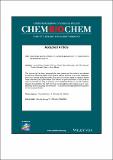Morphology-specific inhibition of β-amyloid aggregates by 17β-hydroxysteroid dehydrogenase type 10
Abstract
A major hallmark of Alzheimer's disease (AD) is the formation of toxic aggregates composed of the β-amyloid peptide (Aβ). Given that Aβ peptides are known to co-localize within mitochondria and interact with 17β-HSD10, a mitochondrial protein expressed at high levels in AD brains, we have investigated the inhibitory potential of 17β-HSD10 against Aβ aggregation across a range of physiological conditions. The fluorescence self-quenching (FSQ) of Aβ(1-42), labelled with HiLyte Fluor 555, was used as a sensing strategy to evaluate the inhibitory effect of 17β-HSD10 under well-established conditions to grow distinct Aβ morphologies. Our results indicate that 17β-HSD10 preferentially inhibits the formation of globular and fibrillar-like structures but has no effect on the growth of amorphous plaque-like aggregates at endosomal pH 6. This work provides insights into the dependence of the Aβ-17β-HSD10 interaction with the morphology of Aβ aggregates and how this impacts enzymatic function.
Citation
Aitken , L , Quinn , S D , Perez-Gonzalez , D C , Samuel , I D W , Penedo-Esteiro , J C & Gunn-Moore , F J 2016 , ' Morphology-specific inhibition of β-amyloid aggregates by 17β-hydroxysteroid dehydrogenase type 10 ' , ChemBioChem , vol. 17 , no. 11 , pp. 1029-1037 . https://doi.org/10.1002/cbic.201600081
Publication
ChemBioChem
Status
Peer reviewed
ISSN
1439-4227Type
Journal article
Description
This research is part-funded by the MSD Scottish Life Sciences fund. As part of an on-going contribution to Scottish life sciences, MSD Limited, a global healthcare leader, has given substantial monetary funding to the Scottish Funding Council (SFC) for distribution via the Scottish Universities Life Science Alliance (SULSA) to develop and deliver a high quality drug discovery research and training programme. All aspects of the programme have been geared towards attaining the highest value in terms of scientific discovery, training and impact. The opinions expressed in this research are those of the authors and do not necessarily represent those of MSD Limited, nor its Affiliates. This research was also kindly supported by Alzheimer’s Society, specifically The Barcopel Foundation, EPSRC, and BBSRC.Collections
Items in the St Andrews Research Repository are protected by copyright, with all rights reserved, unless otherwise indicated.

